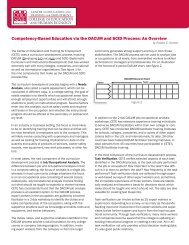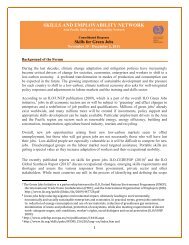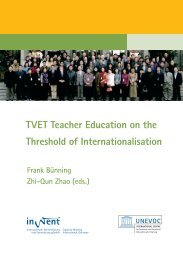Lifelong learning and training: a bridge to the future - Unesco-Unevoc
Lifelong learning and training: a bridge to the future - Unesco-Unevoc
Lifelong learning and training: a bridge to the future - Unesco-Unevoc
You also want an ePaper? Increase the reach of your titles
YUMPU automatically turns print PDFs into web optimized ePapers that Google loves.
In many countries, especially industrialised ones, <strong>the</strong> centre of gravity of vocational<br />
education systems is generally located nearer <strong>to</strong> societal <strong>and</strong> labour market needs, at <strong>the</strong> expense<br />
of educational values <strong>and</strong> individual needs. In many o<strong>the</strong>r countries, especially developing ones,<br />
<strong>the</strong> centre of gravity is located nearer <strong>to</strong> educational criteria <strong>and</strong> st<strong>and</strong>ards, at <strong>the</strong> expense of<br />
labour market needs <strong>and</strong> employment requirements.<br />
In my address, three main vocational education issues will be explored, that are of special<br />
importance in general, <strong>and</strong> in developing countries in particular. These issues are: <strong>the</strong><br />
economics of vocational education, <strong>the</strong> social status of vocational education, <strong>and</strong> <strong>the</strong> regional<br />
<strong>and</strong> international dimensions of vocational education.<br />
The economics of vocational education<br />
Three major fac<strong>to</strong>rs have <strong>to</strong> be explored when <strong>the</strong> economics of vocational education<br />
systems are discussed. The first fac<strong>to</strong>r is concerned with <strong>the</strong> sources of finance <strong>and</strong> methods of<br />
funding; while <strong>the</strong> second fac<strong>to</strong>r is concerned with such matters as costs, efficiency <strong>and</strong><br />
effectiveness, <strong>and</strong> hence with <strong>the</strong> socio-economic return on investment in vocational education.<br />
The third fac<strong>to</strong>r caters for <strong>the</strong> evaluation <strong>and</strong> assessment of <strong>the</strong> relevant systems <strong>and</strong><br />
programmes.<br />
The sources of finance <strong>and</strong> methods of funding of vocational education programmes vary<br />
considerably. Never<strong>the</strong>less, two such sources predominate: <strong>the</strong> first represents <strong>the</strong> taxpayers<br />
through central <strong>and</strong>/or local budgets, while <strong>the</strong> second source represents employers in industry<br />
<strong>and</strong> business, who are <strong>the</strong> main beneficiaries of <strong>the</strong> output of vocational education systems.<br />
O<strong>the</strong>r sources with less impact include learners <strong>and</strong> trainees <strong>the</strong>mselves <strong>and</strong> <strong>the</strong>ir families, in <strong>the</strong><br />
case of fee-paying programmes; income generating activities; grants <strong>and</strong> donations, especially<br />
for such programmes as those directed <strong>to</strong> special groups, including <strong>the</strong> h<strong>and</strong>icapped <strong>and</strong> <strong>the</strong><br />
underprivileged. In most developing countries, public sources of finance for vocational<br />
education usually predominate. Public funding is in general utilised <strong>to</strong> finance school systems,<br />
<strong>and</strong> suffers usually from being inadequate, especially in countries with limited resources, where<br />
vocational education is not considered a priority in national budgets. A dynamic multi-faceted<br />
approach <strong>to</strong> <strong>the</strong> funding issue, with <strong>the</strong> objective of diversifying sources of finance, should be<br />
adopted in developing countries <strong>to</strong> ensure adequacy <strong>and</strong> sustainability of funding. Such an<br />
approach has yet <strong>to</strong> gain recognition <strong>and</strong> feasibility in such countries.<br />
Matters related <strong>to</strong> cost, efficiency <strong>and</strong> effectiveness of vocational education schemes,<br />
which represent <strong>the</strong> second fac<strong>to</strong>r concerning <strong>the</strong> economics of such schemes, pose a big<br />
challenge in most developing countries. The relevant issues here include, on <strong>the</strong> planning or<br />
macro level, system choice or <strong>the</strong> school vs. <strong>the</strong> enterprise issue, <strong>the</strong> broad vs. <strong>the</strong> narrow base<br />
approach <strong>to</strong> <strong>the</strong> area of specialisation, <strong>and</strong> <strong>the</strong> duration of <strong>the</strong> vocational education programme.<br />
On <strong>the</strong> operational or micro level, such issues include trainee-instruc<strong>to</strong>r ratios, utilisation fac<strong>to</strong>rs<br />
of <strong>training</strong> facilities, choice of equipment <strong>and</strong> technologies, <strong>and</strong> size <strong>and</strong> nature of productive<br />
activities.<br />
Evaluation systems <strong>and</strong> techniques, which represent <strong>the</strong> third fac<strong>to</strong>r concerning <strong>the</strong><br />
economics of vocational education, are far from being common practice in developing countries.<br />
To be effective, evaluation systems should incorporate three main elements. The first is internal<br />
evaluation, which is mainly concerned with assessing <strong>the</strong> degree of compatibility between <strong>the</strong><br />
∼ 10 ∼
















